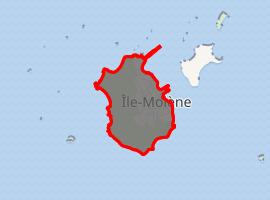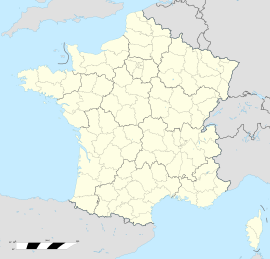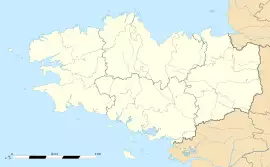Île-Molène Molenez | |
|---|---|
 A general view of Molène | |
Location of Île-Molène  | |
| Coordinates: 48°23′50″N 4°57′20″W / 48.3972°N 4.9556°W | |
| Country | France |
| Region | Brittany |
| Department | Finistère |
| Arrondissement | Brest |
| Canton | Saint-Renan |
| Intercommunality | Pays d'Iroise |
| Government | |
| • Mayor (2014–2020) | Daniel Masson |
| Area 1 | 0.75 km2 (0.29 sq mi) |
| Population (2017)[1] | 141 |
| • Density | 190/km2 (490/sq mi) |
| Time zone | UTC+01:00 (CET) |
| • Summer (DST) | UTC+02:00 (CEST) |
| INSEE/Postal code | 29084 /29259 |
| Elevation | 0–26 m (0–85 ft) |
| 1 French Land Register data, which excludes lakes, ponds, glaciers > 1 km2 (0.386 sq mi or 247 acres) and river estuaries. | |
Molène (Breton: Molenez) is an island off the west coast of Brittany and one of the Ponant Isles, making it the largest of an archipelago of twenty islands. In tiers of government it is in Finistère, a department of Brittany in north-western France – specifically at the heart of the commune of Île-Molène, which takes in neighbouring islets.
Geography
The island is small, less than 1 by 0.9 km (0.56 mi), and covers under 75 hectares (190 acres) of non-foreshore land. The community and port are on the east side, opposite a tiny tidal island, the Lédénes of Molène.
Population
Inhabitants of Île-Molène are called in French Molénais. Usual residents have fallen in recent decades, but Molène remains inhabited, with a permanent population of 169 (2013 census).
| Year | Pop. | ±% |
|---|---|---|
| 1962 | 596 | — |
| 1968 | 527 | −11.6% |
| 1975 | 397 | −24.7% |
| 1982 | 330 | −16.9% |
| 1990 | 277 | −16.1% |
| 1999 | 264 | −4.7% |
| 2008 | 214 | −18.9% |
| 2013 | 169 | −21.0% |
Amenities
The island's electricity is produced by a small diesel generator. Potable water supplies are from rainwater catchment, with each household additionally maintaining its own cistern.
A local delicacy is Molène sausage, which has the distinction of being smoked with seaweed.
Wreckage history
Per a repetitive old Breton proverb, "Qui voit Molène voit sa peine / Qui voit Ouessant voit son sang / Qui voit Sein voit sa fin / Qui voit Groix voit sa croix." ("Who sees Molène sees his pain/penalty / who sees Ushant sees his blood / who sees Sein sees his end / who sees Groix sees his cross"). This proverb underlines local points being often deadly to navigate.
See also
- Communes of the Finistère department
- Parc naturel régional d'Armorique
References
External links
- Official website (in French)
- Base Mérimée: Search for heritage in the commune, Ministère français de la Culture. (in French)

